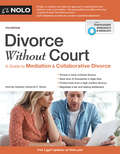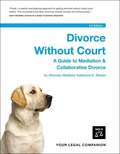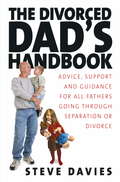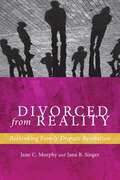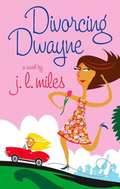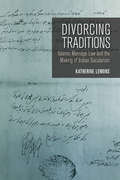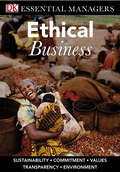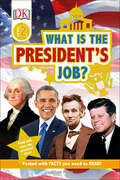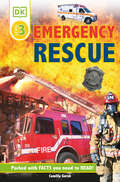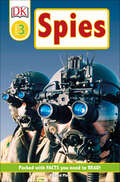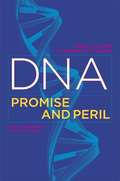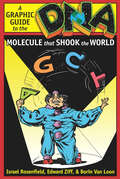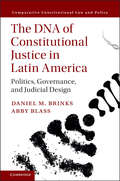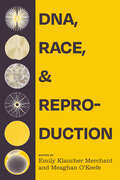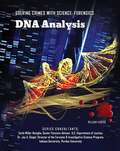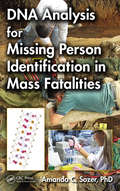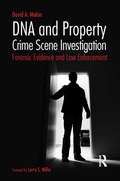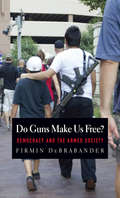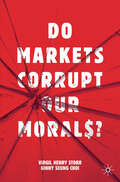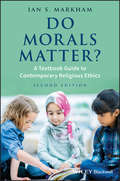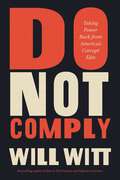- Table View
- List View
Divorce Without Court: A Guide to Mediation and Collaborative Divorce
by Katherine StonerLearn how to end a marriage fairly and inexpensively. This book guides you through a negotiated divorce, using mediation or an increasingly popular approach called collaborative divorce. Encouraging and straightforward, Divorce Without Court explains: how divorce mediation works how collaborative divorce works how to maximize opportunities for settlement how to get an agreement in writing how to find and use advisors. Divorce Without Courtt provides the latest resources, contact information for state offices, national and regional organizations, and clear examples of what you can expect. Includes downloadable worksheets and checklists to help you through the process.
Divorce Without Court: A Guide to Mediation and Collaborative Divorce
by Katherine E. StonerStoner, an attorney and mediator in private practice, explains how to use mediation or collaborative divorce to end a marriage and how to maximize opportunities for settlement, create a written agreement, and find and use advisors. Written in a straightforward, jargon-free style, the guide lists contact information for state offices and national and regional organizations. Stoner also provides worksheets and checklists. Annotation ©2006 Book News, Inc., Portland, OR (booknews.com)
The Divorced Dads' Handbook: Advice, Support and Guidance for all Fathers Going through Separation or Divorce
by Steve DaviesThis book provides practical hard-to-find help to fathers who are separated from their kids. It covers various relevant areas from legal (UK law) and financial to emotional and recreational. This work is delivered in a down-to-earth and accessible style. Contents: 1. Separation; 2. Seeing your kids:the first few months; 3. Contact arrangements; 4. Court orders: dealing with family courts; 5. Mediation services; 6. Your financial responsibility to your children; 7. Ongoing parenting: become a great dad; 8. Building your own support network; 9. Paternity issues; 10. Parent Alienation Syndrome; Useful contacts; Index.
Divorced from Reality: Rethinking Family Dispute Resolution (Families, Law, and Society #5)
by Jana B. Singer Jane C. MurphyOver the past thirty years, there has been a dramatic shift in the way the legal system approaches and resolves family disputes. Traditionally, family law dispute resolution was based on an "adversary" system: two parties and their advocates stood before a judge who determined which party was at fault in a divorce and who would be awarded the rights in a custody dispute. Now, many family courts are opting for a "problem-solving" model in which courts attempt to resolve both legal and non-legal issues. At the same time, American families have changed dramatically. Divorce rates have leveled off and begun to drop, while the number of children born and raised outside of marriage has increased sharply. Fathers are more likely to seek an active role in their children's lives. While this enhanced paternal involvement benefits children, it also increases the likelihood of disputes between parents. As a result, the families who seek legal dispute resolution have become more diverse and their legal situations more complex. In Divorced from Reality, Jane C. Murphy and Jana B. Singer argue that the current "problem solving" model fails to address the realities of today's families. The authors suggest that while today's dispute resolution regime may represent an improvement over its more adversary predecessor, it is built largely around the model of a divorcing nuclear family with lawyers representing all parties--a model that fits poorly with the realities of today's disputing families. To serve the families it is meant to help, the legal system must adapt and reshape itself.
Divorcing Dwayne (Francine Harper, Book #1)
by J. L. MilesFrancine Harper's in the Pickville Springs County Jail facing felony assault charges. Her offense? She shot at her husband, Dwayne, and his lover, Carla, after catching them together-- in the very bed her daddy had carved and given to Francine and Dwayne on their wedding day. Even though she hit the bed and missed the lovers, she soon learns she's committed a felony, and the deputy district attorney-- who's never been fond of her since she jilted his brother-- is determined to prosecute her to the fullest extent of the law. On the other hand, Dwayne is a local celebrity, a talented fiddle player with his own bluegrass band, the Rocky Bottom River Boys. Things are looking up for the band, and they have been selected to record the soundtrack for director Frederick Ford Gumbello's latest film, Oh Mother, Oh Father, Where Art Thou? When Gumbello comes to town to meet the boys, he becomes enamored with the locale and stays to film the movie since Pickville Springs is the perfect setting for the film. When Francine makes bail, aided by her best friend, Ray Anne Pickles, she discovers that the checking account she shares with Dwayne contains thirty thousand dollars she can't account for, and she starts worrying about him. Strange things have been going on, and she still loves him. But she fears that he may have gotten involved with the local mob. Soon Francine finds herself in the arms of rising movie star Clay Carson, which is the last straw for Dwayne, who assaults Clay and disappears. When Dwayne can't be found anywhere, Francine is suspected of foul play, and is arrested for his suspected murder. But Francine is determined to find Dwayne, save him from the mob, and solve the mystery-- with Ray Anne's help, of course. In the interim, she discovers inner strengths and regains her dignity. Now the situation with Dwayne-- that's another story.
Divorcing Traditions: Islamic Marriage Law and the Making of Indian Secularism
by Katherine LemonsDivorcing Traditions is an ethnography of Islamic legal expertise and practices in India, a secular state in which Muslims are a significant minority and where Islamic judgments are not legally binding. Katherine Lemons argues that an analysis of divorce in accordance with Islamic strictures is critical to the understanding of Indian secularism. Lemons analyzes four marital dispute adjudication forums run by Muslim jurists or lay Muslims to show that religious law does not muddle the categories of religion and law but generates them. Drawing on ethnographic and archival research conducted in these four institutions—NGO-run women's arbitration centers (mahila panchayats); sharia courts (dar ul-qazas); a Muslim jurist's authoritative legal opinions (fatwas); and the practice of what a Muslim legal expert (mufti) calls "spiritual healing"—Divorcing Traditions shows how secularism is an ongoing project that seeks to establish and maintain an appropriate relationship between religion and politics. A secular state is always secularizing. And yet, as Lemons demonstrates, the state is not the only arbiter of the relationship between religion and law: religious legal forums help to constitute the categories of private and public, religious and secular upon which secularism relies. In the end, because Muslim legal expertise and practice are central to the Indian legal system and because Muslim divorce's contested legal status marks a crisis of the secular distinction between religion and law, Muslim divorce, argues Lemons, is a key site for understanding Indian secularism.
DK Essential Managers: Sustainability, Commitment, Values, Transparency, Environment (DK Essential Managers)
by Linda Ferrell O.C. FerrellEthical Business gives you the know-how to get results without getting ruthless. This book will teach you how to improve your bottom line and employee morale while listening to your conscience.It is practical, handy guide to ethical business skills which will give you the information and skills to succeed. Develop your ethical business skills by learning to assess your business, establish alternatives and plan for change. Step-by-step instructions, checklists and features examine business benefits, environmental impact, and human resources implications of each decision. Tips, dos and don'ts, "In Focus" features, and real-life case studies demonstrate how to plan your ethical strategy, monitor progress and achieve your goals. Read it cover-to-cover, or dip in and out of topics for quick reference.About DK Essential Managers: The DK Essential Managers series covers a range of business and management topics and has sold more than two million copies worldwide. Each guide is clearly presented for ease of reference, with visual pointers, tips, and graphics.
DK Readers L2: What is the President's Job? (DK Readers Level 2)
by Allison Singer DKFind out what the president does as you learn about the executive branch of government and see what a day in the life of the commander in chief is really like.This leveled DK Reader will build reading skills while teaching exciting political vocabulary and showing how the leader of the United States helps decide the country's laws, what traditions the president takes part in, and how the POTUS meets with other countries to make sure there is peace and goodwill.Travel to Washington, DC, and take a sneak peek inside the Oval Office to see what it takes to be president in What is the President's Job?Perfect for 5–7 year olds beginning to read fluently with support, Level 2 titles contain carefully selected photographic images to complement the text, providing strong visual clues to build vocabulary and confidence. Additional information spreads are full of extra fun facts, developing the topics through a range of nonfiction presentation styles such as diagrams and activities.
DK Readers L2: What is the President's Job? (DK Readers Level 2)
by Allison Singer DKFind out what the president does as you learn about the executive branch of government and see what a day in the life of the commander in chief is really like.This leveled DK Reader will build reading skills while teaching exciting political vocabulary and showing how the leader of the United States helps decide the country's laws, what traditions the president takes part in, and how the POTUS meets with other countries to make sure there is peace and goodwill.Travel to Washington, DC, and take a sneak peek inside the Oval Office to see what it takes to be president in What is the President's Job?Perfect for 5–7 year olds beginning to read fluently with support, Level 2 titles contain carefully selected photographic images to complement the text, providing strong visual clues to build vocabulary and confidence. Additional information spreads are full of extra fun facts, developing the topics through a range of nonfiction presentation styles such as diagrams and activities.
DK Readers L3: Meet Real-Life Heroes! (DK Readers Level 3)
by Camilla GershWhat's your emergency? From flashing lights and blaring sirens to K-9 units and EMTs, emergency services have vital roles in saving lives. Find out what it takes to respond to an emergency in Emergency Rescue.Learn police officers' secret radio code, look at a firefighter's daily schedule, and hear what emergency dispatchers say on the phone. Make sure you are prepared for an emergency and that you know who to call!Emergency Rescue shows how hard emergency responders, police officers, and firefighters work to save lives, and the important work they do to keep everyone safe.Perfect for 7–9 year olds starting to read alone, Level 3 titles include in-depth information presented through more complex sentence structure with increasing amount of text to expand the reader's general knowledge and confidence in reading. Additional information spreads are full of extra facts, developing the topics through a range of nonfiction presentation styles, such as fliers, instructions, and record-breaker statistics.Lexile measure: 800 Fountas and Pinnell Text Level Gradient: OTrusted by parents, teachers, and librarians, and loved by kids, DK's leveled reading series is now revised and updated. With shiny new jackets and brand new nonfiction narrative content on the topics kids love, each book is written and reviewed by literacy experts, and contains a glossary and index making them the perfect choice for helping develop strong reading habits for kids ages 3–11.
DK Readers L3: Meet Real-Life Heroes! (DK Readers Level 3)
by Camilla GershWhat's your emergency? From flashing lights and blaring sirens to K-9 units and EMTs, emergency services have vital roles in saving lives. Find out what it takes to respond to an emergency in Emergency Rescue.Learn police officers' secret radio code, look at a firefighter's daily schedule, and hear what emergency dispatchers say on the phone. Make sure you are prepared for an emergency and that you know who to call!Emergency Rescue shows how hard emergency responders, police officers, and firefighters work to save lives, and the important work they do to keep everyone safe.Perfect for 7–9 year olds starting to read alone, Level 3 titles include in-depth information presented through more complex sentence structure with increasing amount of text to expand the reader's general knowledge and confidence in reading. Additional information spreads are full of extra facts, developing the topics through a range of nonfiction presentation styles, such as fliers, instructions, and record-breaker statistics.Lexile measure: 800 Fountas and Pinnell Text Level Gradient: OTrusted by parents, teachers, and librarians, and loved by kids, DK's leveled reading series is now revised and updated. With shiny new jackets and brand new nonfiction narrative content on the topics kids love, each book is written and reviewed by literacy experts, and contains a glossary and index making them the perfect choice for helping develop strong reading habits for kids ages 3–11.
DK Readers L3: Spies! (DK Readers Level 3)
by Richard PlattExplore the history of espionage with the DK Reader Spies! Meet the famous and the infamous—the agents and the double agents. Infiltrate the FBI, CIA, and KGB, and follow the evolution of the tools of the trade, including industrial spying and computer hackers.Stunning photographs combine with lively illustrations and engaging, age-appropriate stories in DK Readers, a multilevel reading program guaranteed to capture children's interest while developing their reading skills and general knowledge. With DK Readers, children will learn to read—then read to learn!
DK Readers L3: Spies! (DK Readers Level 3)
by Richard PlattExplore the history of espionage with the DK Reader Spies! Meet the famous and the infamous—the agents and the double agents. Infiltrate the FBI, CIA, and KGB, and follow the evolution of the tools of the trade, including industrial spying and computer hackers.Stunning photographs combine with lively illustrations and engaging, age-appropriate stories in DK Readers, a multilevel reading program guaranteed to capture children's interest while developing their reading skills and general knowledge. With DK Readers, children will learn to read—then read to learn!
DNA: Promise and Peril
by Linda L. Mccabe Edward R. B. MccabeThis book gives the background information critical to understanding how genetics is now affecting our everyday lives. It gives a comprehensive view of exciting recent discoveries and explores the ethical, legal, and social issues that have arisen with each new development.
DNA: A Graphic Guide to the Molecule that Shook the World
by Israel Rosenfield Edward Ziff Borin Van LoonA graphic portrayal of a complicated science for a wide range of readers, full of humor, depth, and philosophical and historical insight. Suitable for use in and out of the classroom, this volume covers DNA&’s many marvels, from its original discovery in 1869 to early-twentieth-century debates on the mechanisms of inheritance and the deeper nature of life&’s evolution and variety. Even readers who lack a background in science and philosophy will learn a tremendous amount from this engaging narrative. The book elucidates DNA&’s relationship to health and the cause and cure of disease. It also covers the creation of new life forms, nanomachines, and perspectives on crime detection, and considers the philosophical sources of classical Darwinian theory and recent, radical changes in the understanding of evolution itself. Already these developments have profoundly affected our notions about living things. Borin Van Loon&’s humorous illustrations recount the contributions of Gregor Mendel, Frederick Griffith, James Watson, and Francis Crick, among other biologists, scientists, and researchers, and vividly depict the modern controversies surrounding the Human Genome Project and cloning. &“A unique, richly detailed, and fun biography of DNA grounded in deep historical and philosophical knowledge . . . Everything we need to know about biology&’s most important molecule.&” —Olive Sacks, author of Everything In Its Place &“A remarkable book . . . Novel, easy to read, and fun . . . I spent many years mastering genetics yet learned new and valuable things from this book.&” —Robert Trivers, author of Wild Life: Adventures of an Evolutionary Biologist
The DNA of Constitutional Justice in Latin America: Politics, Governance, and Judicial Design (Comparative Constitutional Law And Policy )
by Daniel M. Brinks Abby BlassIn recent times there has been a dramatic change in the nature and scope of constitutional justice systems in the global south. New or reformed constitutions have proliferated, protecting social, economic, and political rights. <P><P>While constitutional courts in Latin America have traditionally been used as ways to limit power and preserve the status quo, the evidence shows that they are evolving into a functioning part of contemporary politics and a central component of a system of constitutional justice. <P>This book lays bare the political roots of this transformation, outlining a new way to understand judicial design and the very purpose of constitutional justice. Authors Daniel M. Brinks and Abby Blass use case studies drawn from nineteen Latin American countries over forty years to reveal the ideas behind the new systems of constitutional justice. They show how constitutional designers entrust their hopes and fears to dynamic governance systems, in hopes of directing the development of constitutional meaning over time.
DNA, Race, and Reproduction
by Emily Klancher Merchant and Meaghan O’KeefeA free ebook version of this title is available through Luminos, University of California Press's Open Access publishing program. Visit www.luminosoa.org to learn more.DNA, Race, and Reproduction helps readers inside and outside of academia evaluate and engage with the current genomic landscape. It brings together expertise in law, medicine, religion, history, anthropology, philosophy, and genetics to examine how scientists, medical professionals, and laypeople use genomic concepts to construct racial identity and make or advise reproductive decisions, often at the same moment. It critically and accessibly interrogates how DNA figures in the reproduction of racialized bodies and the racialization of reproduction and examines the privileged position from which genomic knowledge claims to speak about human bodies, societies, and activities. The volume begins from the premise that reproduction, regardless of the means, forces a confrontation between biomedical, scientific, and popular understandings of genetics, and that those understandings are often racialized. It therefore centers reproduction as both a site of analysis and an analytic lens.
DNA Analysis (Solving Crimes With Science: Forensics #12)
by William HunterA flake of skin...a strand of hair...a fleck of saliva...a drop of blood...everywhere we go we leave behind bits of ourselves that are as unique as fingerprints. Each cell contains genetic material called DNA, which holds information that scientists can use to learn about the person who left those cells behind. In the past twenty-five years, researchers have made significant advances in all disciplines of science, including the study of genetics. As science has leapt forward, the effect on forensics has been remarkable. New knowledge of DNA has dramatically changed the amount of information available to forensic scientists at the scene of a crime, opening doors that were never open before.
DNA Analysis for Missing Person Identification in Mass Fatalities
by Amanda C SozerAdvances in DNA technology have expanded such that forensic DNA profiling is now considered a routine method for identifying victims of mass fatalities. Originating from an initiative funded by a grant from the U.S. Department of State, DNA Analysis for Missing Person Identification in Mass Fatalities presents a collection of training modules that
DNA and Property Crime Scene Investigation: Forensic Evidence and Law Enforcement
by David A. MakinTraditionally, forensic investigation has not been fully utilized in the investigation of property crime. This ground-breaking book examines the experiences of patrol officers, command staff, detectives, and chiefs as they navigate the expectations of forensic evidence in criminal cases, specifically property crimes cases. DNA and Property Crime Scene Investigation looks at the current state of forensic technology and, using interviews with police officers, command staff, forensic technicians, and prosecutors, elucidates who is doing the work of forensic investigation. It explores how better training can decrease backlogs in forensic evidence processing and prevent mishandling of crucial evidence. Concluding with a police chief's perspective on the approach, DNA and Property Crime Scene Investigation provides insight into an emerging and important approach to property crime scene investigation. Key Features Provides practical information on implementing forensic investigation for property crimes Examines the current state of forensic technology and points to future trends Includes a police chief's perspective on the forensic approach to investigating property crimes Utilizes interviews with professionals in the field to demonstrate the benefits of the approach
Do Financial Sector Reforms Lead to Financial Development? Evidence from a New Dataset
by Thierry Tressel Enrica DetragiacheA report from the International Monetary Fund.
Do Guns Make Us Free?: Democracy and the Armed Society
by Firmin DeBrabanderThis study investigates the relationship between gun ownership and democracy, exposing the dubious claims of the NRA and other gun rights supporters. One of the most vital and polarizing debates in American society today concerns the Second Amendment of the Constitution and the rights of citizens to bear arms. The core argument of gun advocates like the National Rifle Association is that the proliferation of firearms is essential to maintaining freedom in America. They contend that access to guns gives private citizens a defense against possible government tyranny, thereby safeguarding all our other rights. But is this argument valid? Do guns indeed make us free? Firmin DeBrabrander examines claims offered in favor of unchecked gun ownership in this insightful and eye-opening analysis. By exposing the contradictions and misinterpretations presented by gun rights supporters, DeBradander concludes that an armed society is not a free society but one that, in fact, actively hinders democratic participation.
Do Markets Corrupt Our Morals?
by Virgil Henry Storr Ginny Seung ChoiThe most damning criticism of markets is that they are morally corrupting. As we increasingly engage in market activity, the more likely we are to become selfish, corrupt, rapacious and debased. Even Adam Smith, who famously celebrated markets, believed that there were moral costs associated with life in market societies. This book explores whether or not engaging in market activities is morally corrupting. Storr and Choi demonstrate that people in market societies are wealthier, healthier, happier and better connected than those in societies where markets are more restricted. More provocatively, they explain that successful markets require and produce virtuous participants. Markets serve as moral spaces that both rely on and reward their participants for being virtuous. Rather than harming individuals morally, the market is an arena where individuals are encouraged to be their best moral selves. Do Markets Corrupt Our Morals? invites us to reassess the claim that markets corrupt our morals.
Do Morals Matter?: A Textbook Guide to Contemporary Religious Ethics
by Ian S. MarkhamThe revised second edition of the accessible guide to contemporary ethical issues that are at the intersection of religion and morality The updated second edition of Do Morals Matter? offers an authoritative yet approachable guide to the current ethical issues that bridge the gap between religion and morality. This informed text examines today’s key ethical issues that range from making moral decisions in business and medicine, to the uncertainty of war and terrorism and the tenuous condition of our environment. This popular textbook embraces the dramatic changes that have occurred since the first edition was published such as changes in attitude towards the LGBT community as well as emerging ethical areas such as cyber ethics. In consultation with professors, the new edition includes sections at the beginning and end of each chapter that provide clear and succinct summaries of key issues, as well as reflective and discussion questions. This revised text: Sets out all the major ethical options in a balanced way inviting students to make their own mind up Deals with both moral philosophy and applied ethics Starts every chapter with a thought-exercise to provoke discussion Places Brexit and President Trump in an appropriate ethical framework Develops the concept of a Morally Serious Person. Written for students studying ethics in departments of theology and religion, Do Morals Matter? is the thoroughly revised and updated edition of the text that explores contemporary ethical issues.
Do Not Comply: Taking Power Back from America's Corrupt Elite
by Will WittFrom bestselling author Will Witt, this thought-provoking exposé shows readers how to break free from the control of America&’s corrupt ruling class. The America you grew up in is no longer here. Our country is in sharp decline. Yet we often fail to truly call out the culprits responsible for it. Who are the corrupters of our great country? They are politicians (both Democrat and Republican), they are businessmen, they are celebrities, they are media executives, they are scientists. They are the elite. And they are selfish. In Do Not Comply, one of America&’s most articulate and fastest rising political commentators on the right exposes the elite&’s many lies holding America hostage. Witt persuasively explains how a corrupt ruling class has pitted us against each other in the name of &“the greater good&” and &“building back better.&” But the changes and programs they institute have only hurt us in the long run and have sent us spiraling to serfdom while the elites reap all the benefits. Without fear or favor, the independent-minded Witt deconstructs the misguided policies and adventures of America&’s political, pharmaceutical, tech, media, and financial institution elite – with surprising takeaways. Through systematically looking at the biggest issues used to divide us today, Witt answers these crucial questions about the future of America: How do the elite achieve their power? How do we fix the vexing problems in our society caused by this greed and selfishness? And how do we take our power back? From one of America&’s brightest young minds, this book is a must-read for citizens seeking the truth about who really controls the levers of power in our country. As we watch America descend toward moral and economic destruction, it&’s tempting to believe we have no power to enact change. But we always have a choice—and it&’s not too late. Do Not Comply is the first step towards righting the ship.
